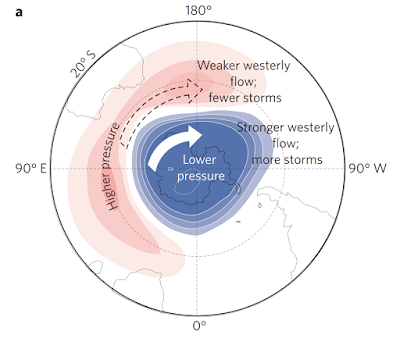I am studying for an MSc in Climate Change at UCL and it is my own lack of knowledge and awareness about the impacts of climate change in Antarctica that have drawn me to choose it as a topic for this blog series.
Changing Planet
Throughout
the Earth’s history the concentration of carbon dioxide has fluctuated and the
average temperature across the globe has varied. However, since the Industrial
Revolution, anthropogenic activities have increased greenhouse gases in the
atmosphere which has caused global surface temperature increases (across both land and ocean) of 0.85°C between 1880 to 2012. According to
the IPCC’s Fifth Assessment Report:
“Warming
of the climate system is unequivocal, and since the 1950s, many of the observed
changes are unprecedented over decades to millennia. The atmosphere and ocean
have warmed, the amounts of snow and ice have diminished, sea level has risen,
and the concentrations of greenhouse gases have increased”
 |
| Global atmospheric concentrations of CO2 over time (Image: EPA) |
The Polar South: Antarctica
The Poles are frequently used
as indicators for global climate change: the ice can reveal past changes and assist scientists in modelling the future. The effects of climate change in the Arctic are well documented, and images of polar bears stranded on
icebergs a familiar sight on our news. The Antarctic, on the other hand, receives less attention.
The most southern, and fifth largest, continent is the
coldest, driest and windiest on Earth. Comprised of two distinct regions, the West
and East, The Antarctic holds roughly 61% of the Earth’s freshwater and is the site of the lowest recorded temperature on Earth, a chilly -89.2°C!
Recent
temperature changes in The Antarctic are complex, with assessments highlighting
spatial heterogeneity. Since the 1950s, monitoring stations have measured some
of the fastest warming on Earth across The Antarctic Peninsula, with temperatures rising by 2.5°C between 1950
and 2000 (Turner et al, 2005). The Peninsula’s response? Worryingly, 87% of the glaciers located there are receding, a large part (twice the size of Luxembourg) of the Larcen C ice shelf broke away this summer and melting
currently contributes a reported 0.22mm per year to global sea level rise.
These temperature increases are, to a lesser extent, being
recorded across the rest of the West Antarctic Ice Sheet (WAIS) as well. According to a paper by Steig et al, 2009, warming has exceeded 0.16°C per decade over the past 50 years.
In contrast, the East Antarctic Ice
Sheet (EAIS) has experienced little change in temperature and even a slight
cooling in places. This means that the mass balance of the ice sheet is in equilibrium or even slightly positive.
Welcome to my Antarctic journey
Over the next few months I will seek to understand, document and answer the following questions:
- How is Antarctica responding to a changing climate and what are the spatial complexities?
- How has Antarctica responded to changing climates in the past?
- What does Antarctica's future look like and what are the implications for the rest of the Earth?
So, for now, it was ‘ice to meet you and I hope you will join me on my journey of Antarctic discovery.










